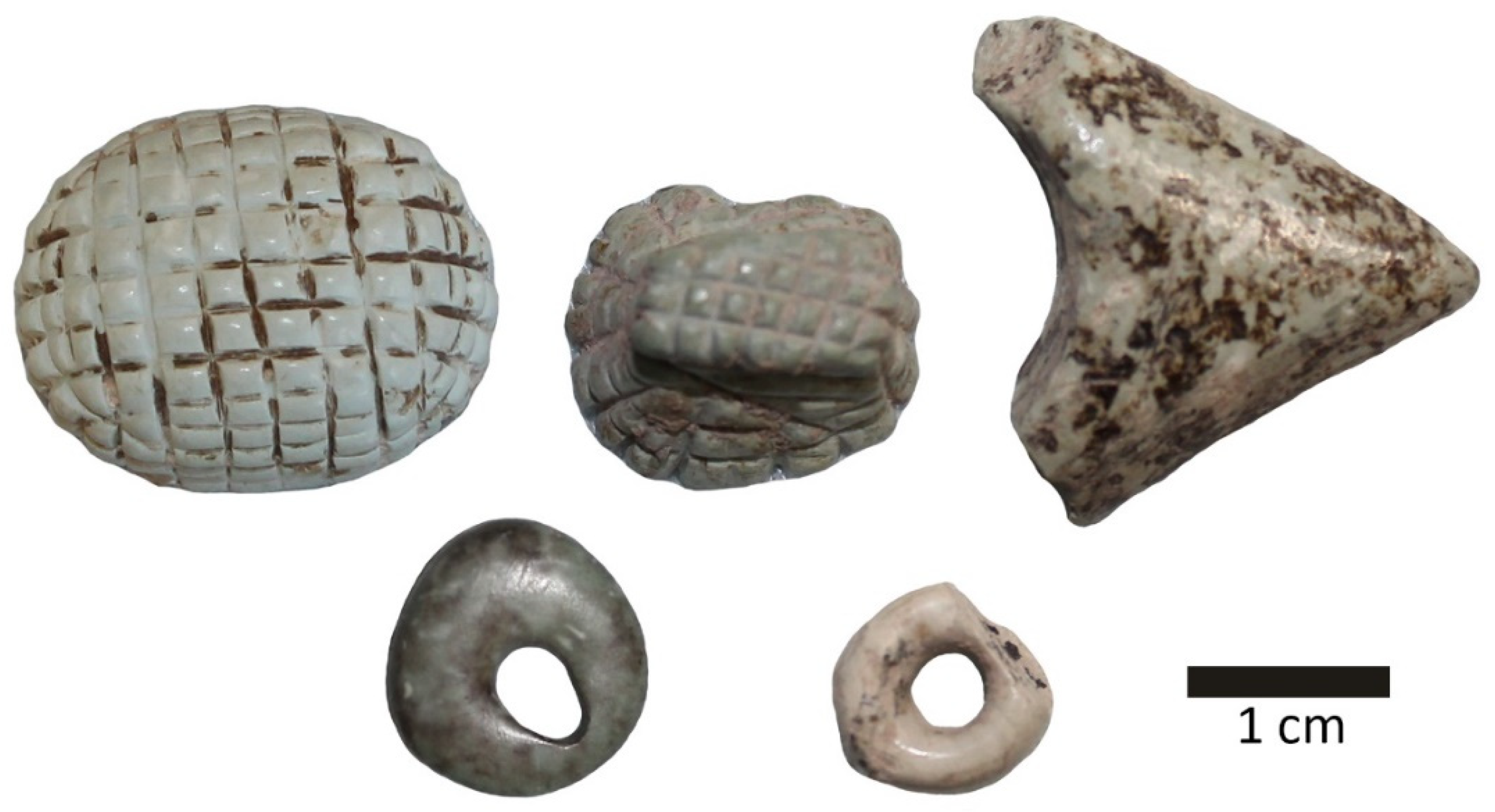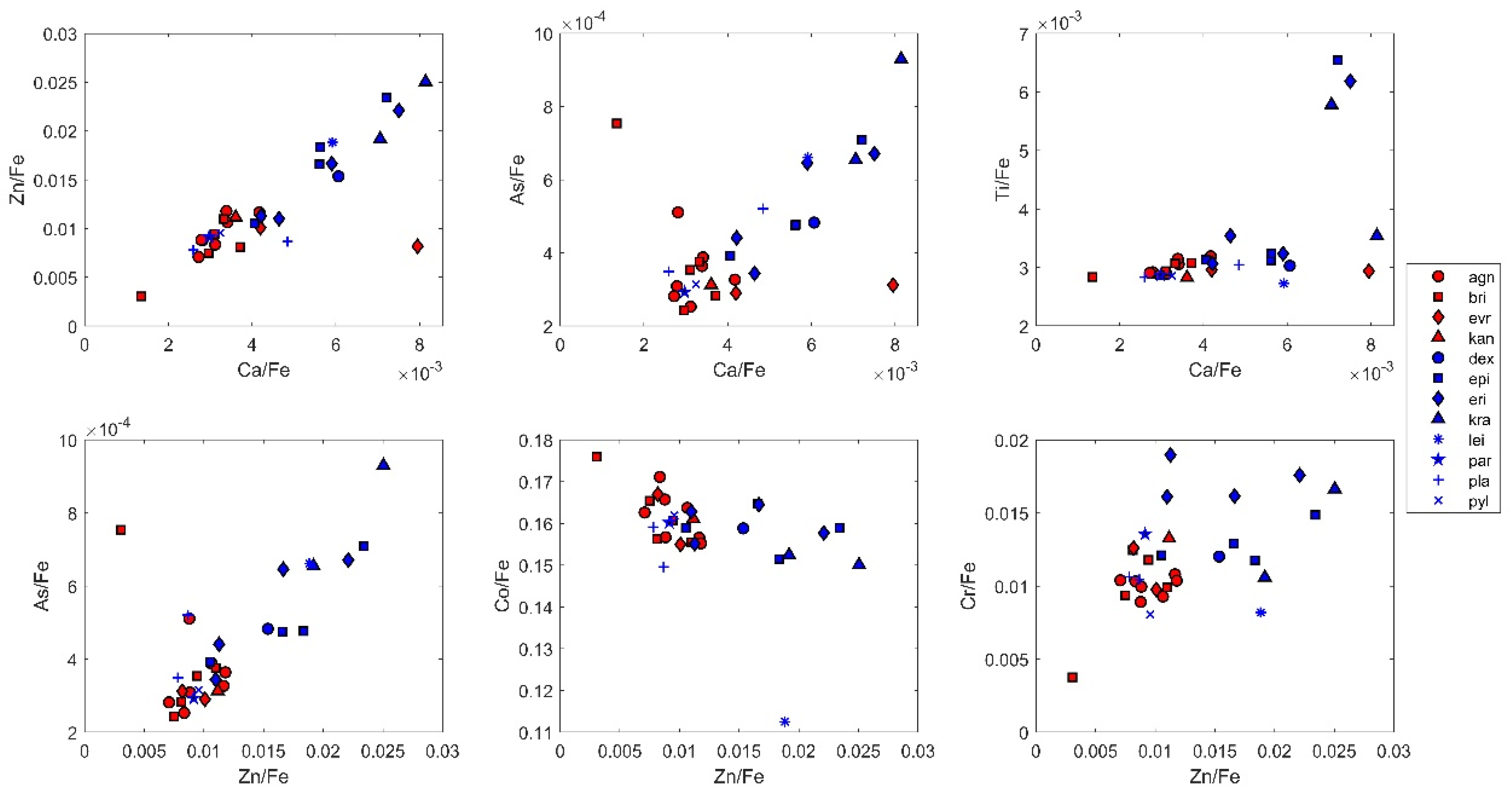X-ray Fluorescence Spectroscopy of Picrolite Raw Material on Cyprus
Abstract
:1. Introduction
Picrolite Use in Cypriot Prehistory
2. Background
2.1. Picrolite Raw Material
2.2. Previous Analytical Studies on Cypriot Picrolite
3. Materials and Methods
3.1. Picrolite Geological Samples
3.2. Sample Preparation
3.3. Handheld Portable XRF (HHpXRF)
3.4. Synchrotron Micro-XRF (SR-μXRF)
3.5. Data Processing
4. Results
4.1. HHpXRF Elemental Analysis
4.2. SR-μXRF Elemental Analysis
4.3. SR-μXRF Imaging
5. Discussion and Conclusions
Supplementary Materials
Author Contributions
Funding
Institutional Review Board Statement
Informed Consent Statement
Data Availability Statement
Acknowledgments
Conflicts of Interest
References
- Peltenburg, E. The Evolution of the Cypriot Cruciform Figurine. Report of the Department of Antiquities, Nicosia, Cyprus; Getty Publications: Los Angeles, CA, USA, 1982. [Google Scholar]
- Campo, A.L. Anthropomorphic Representations in Prehistoric Cyprus: A Formal and Symbolic Analysis of Figurines, c. 3500–1800 BC. (Studies in Mediterranean Archaeology Pocket-Book 109); Paul Åström Förlag: Jonsered, Sweden, 1994. [Google Scholar]
- Crewe, L.; Peltenburg, E.; Spanou, S. Contexts for cruciforms: Figurines of prehistoric Cyprus. Antiquity 2002, 76, 21–22. [Google Scholar] [CrossRef]
- Simmons, A.H. Akrotiri-Aetokremnos (Cyprus) 20 years later: An assessment of its significance. Eurasian Prehistory 2013, 10, 139–156. [Google Scholar]
- Simmons, A.H. Ais Giorkis: An unusual early Neolithic settlement in Cyprus. J. Field Archaeol. 2012, 37, 86–103. [Google Scholar] [CrossRef]
- Peltenburg, E. Local exchange in prehistoric Cyprus: An initial assessment of picrolite. Bull. Am. Sch. Orient. Res. 1991, 282–283, 107–126. [Google Scholar] [CrossRef]
- Moutsiou, T. Raw material circulation and the early holocene social landscape of Cyprus. In Near Eastern Lithic Technologies on the Move. Interactions and Contexts in Neolithic Traditions, Proceedings of the 8th International Conference on PPN Chipped and Ground Stone Industries of the Near East, Nicosia, 23–27 November 2016 (Studies in Mediterranean archaeology Volume 150); Astruc, L., McCartney, C., Briois, F., Kassianidou, V., Eds.; Astrom Editions: Nicosia, Cyprus, 2019; pp. 119–132. [Google Scholar]
- Cnudde, V.; Cnudde, J.P.; Dupuis, C.; Jacobs, P.J.S. X-ray micro-CT used for the localization of water repellents and consolidants inside natural building stones. Mater. Charact. 2004, 53, 259–271. [Google Scholar] [CrossRef]
- Brunetti, A.; Princi, E.; Vicini, S.; Pincin, S.; Bidali, S.; Mariani, A. Visualization of monomer and polymer inside porous stones by using X-ray tomography. Nucl. Instrum. Methods Phys. Res. Sect. B Beam Interact. Mater. At. 2004, 222, 235–241. [Google Scholar] [CrossRef]
- Mazel, V.; Richardin, P.; Debois, D.; Touboul, D.; Cotte, M.; Brunelle, A.; Walter, P.; Laprévote, O. The patinas of the Sogon-Tellem statuary: A new vision through physico-chemical analyses. J. Cult. Herit. 2008, 9, 347–353. [Google Scholar] [CrossRef]
- Le Trong, E.; Rozenbaum, O.; Rouet, J.-L.; Bruand, A. A simple methodology to segment X-ray tomographic images of a multiphasic building stone. Image Anal. Stereol. 2008, 27, 175–182. [Google Scholar] [CrossRef] [Green Version]
- Robertson, E.C.; Blyth, R. XANES investigation of the effects of heat treatment on an archaeological tool stone. In Canadian Light Source 2008 Activity Report; Canadian Light Source, Inc.: Saskatoon, SK, Canada, 2009. [Google Scholar]
- Bertrand, L.; Languille, M.-A.; Cohen, S.X.; Robinet, L.; Gervais, C.; Leroy, S.; Bernard, D.; Le Pennec, E.; Josse, W.; Doucet, J.; et al. European research platform IPANEMA at the SOLEIL synchrotron for ancient and historical materials. J. Synchrotron Radiat. 2011, 18, 765–772. [Google Scholar] [CrossRef] [PubMed] [Green Version]
- Bernardini, F.; Eichert, D.; Lenaz, D.; De Min, A.; Tuniz, C.; Velušček, A.; Montagnari Kokelj, E. Synchrotron FTIR micro-spectroscopy applied to the study of polished serpentinite artefacts: A non-destructive analytical approach. Archaeometry 2011, 53, 753–764. [Google Scholar] [CrossRef]
- Xenophontos, C. Steatite vs. picrolite. P.59 in Early copper-work in Cyprus and the exploitation of picrolite: Evidence from the Lemba archaeological project, by E.J. Peltenburg. In Early Metallurgy in Cyprus, 4000–4500 B.C.; Muhly, J.D., Maddin, R., Karageorghis, V., Eds.; Pierides Foundation: Larnaka, Cyprus, 1981; pp. 41–62. [Google Scholar]
- Whittaker, E.J.W.; Zussman, J. The characterization of serpentine minerals by X-ray diffraction. Mineral. Mag. J. Mineral. Soc. 1956, 23, 107–126. [Google Scholar] [CrossRef]
- Wicks, F.J.; O’Hanley, D.S. Serpentine minerals: Structures and petrology. In Hydrous Phyllosilicates: (Exclusive of Micas); Bailey, S.M.W., Ed.; De Gruyter: Boston, MA, USA, 1988; pp. 91–168. [Google Scholar] [CrossRef]
- Chidester, A.; Albee, A.; Cady, W. Petrology, Structure, and Genesis of the Asbestos-Bearing Ultramafic Rocks of the Belvidere Mountain Area in Vermont; Geological Survey Professional Paper 1016; United States Government Printing Office: Washington, DC, USA, 1978. [Google Scholar]
- Xenophontos, C. Picrolite, its nature, provenance, and possible distribution patterns in the Chalcolithic period of Cyprus. Bull. Am. Sch. Orient. Res. 1991, 282–283, 127–138. [Google Scholar] [CrossRef]
- Dikaios, P. Khirokitia: Final Report on the Excavation of a Neolithic Settlement in Cyprus on Behalf of the Department of Antiquities 1936–1946; Oxford University Press: Oxford, UK, 1953. [Google Scholar]
- Simmons, A.H. Preliminary Report on Multidisciplinary Investigations at Neolithic Kholetria Ortos, Paphos District; Report of the Department of Antiquities; Department of Antiquities: Nicosia, Cyprus, 1996; pp. 29–44. [Google Scholar]
- Peltenburg, E. Picrolite, procurement, manufacture and use. In Figurine Makers of Prehistoric Cyprus: Settlement and Cemeteries at Souskiou; Peltenburg, E., Bolger, D., Crewe, L., Eds.; Oxbow Books: Oxford, UK, 2019; pp. 233–248. [Google Scholar]
- Tack, P.; Bazi, B.; Vekemans, B.; Okbinoglu, T.; Van Maldeghem, F.; Goderis, S.; Schöder, S.; Vincze, L. Investigation of (micro-) meteoritic materials at the new hard X-ray imaging PUMA beamline for heritage sciences. J. Synchrotron Radiat. 2019, 26, 2033–2039. [Google Scholar] [CrossRef] [PubMed]
- Webb, S.M. The MicroAnalysis Toolkit: X-ray Fluorescence Image Processing Software. Am. Inst. Phys. Conf. Proc. 2011, 1365, 196–199. [Google Scholar] [CrossRef] [Green Version]
- Baxter, M.J.; Freestone, I.C. Log-ratio compositional data analysis in archaeometry. Archaeometry 2006, 48, 511–531. [Google Scholar] [CrossRef]
- Bertrand, L.; Cotte, M.; Stampanoni, M.; Thoury, M.; Marone, F.; Schöder, S. Development and trends in synchrotron studies of ancient and historical materials. Phys. Rep. 2012, 519, 51–96. [Google Scholar] [CrossRef]
- Cory-Lopez, E. Technological and material approaches to Cypriot Chalcolithic picrolite. In Cypriot Material Culture Studies from Picrolite Carving to Proskynitaria Analysis, Proceedings of the 8th Annual Postgraduate Cypriot Archaeology Conference Held in Honour of the Memory of Paul Åström at the Vrije Universiteit Brussel (Belgium), 27–29 November 2008; Jacobs, A., Cosyns, P., Eds.; Vubpress: Brussels, Belgium, 2015; pp. 25–45. [Google Scholar]
- Bar-Yosef Mayer, D.; Porat, N. Green stone beads at the dawn of agriculture. Proc. Natl. Acad. Sci. USA 2008, 105, 8548–8551. [Google Scholar] [CrossRef] [Green Version]







| Source | Sample | Area | Source | Sample | Area |
|---|---|---|---|---|---|
| north | agn_120.1 | square | south | dex_110.16 | transect |
| north | agn_118.2 | transect | south (secondary) | epi3_103.2 | square |
| north | agn_118.4 | square | south (secondary) | epi3_103.1 | rectangular |
| north | agn_119.2 | square | south (secondary) | epi8_105.3 | square |
| north | agn_119.4 | transect | south (secondary) | epi8_105.4 * | overview |
| north | agn_120.2 | square | south (secondary) | epi8_105.4 | overview |
| north | agn_120.4 | transect | south (secondary) | epi8_105.4 | transect |
| north (secondary) | bri1_100.1 | square | south (secondary) | epi8_105.4 | vertical lines |
| north (secondary) | bri1_100.2 | transect | south (secondary) | eri6_104.1 | square |
| north (secondary) | bri1_100.3 | square | south (secondary) | eri6_104.4 | square |
| north (secondary) | bri2_101.1 | transect | south (secondary) | eri7_107.1 * | square |
| north (secondary) | bri2_102.2 | square | south (secondary) | eri7_107.1 | square2 |
| north (secondary) | evr_102.1 | square | south | kra_114.12 | transect |
| north (secondary) | evr_102.2 | transect | south | kra_114.13 | square |
| north | kan_117.4 | transect | south | lei_111.14 | transect |
| south (secondary) | par_106.4 * | square | |||
| south (secondary) | par_106.4 | square | |||
| south (secondary) | par_106.4 | square | |||
| south | pla1_115.10 | transect | |||
| south | pla2_116.4 | square | |||
| south | pyl_112.8 | transect |
| Ca/Fe | Ti/Fe | Cr/Fe | Co/Fe | Zn/Fe | As/Fe | |
|---|---|---|---|---|---|---|
| North | 3.51 | 2.97 | 10.20 | 161.91 | 9.04 | 0.36 |
| South | 5.35 | 3.67 | 13.16 | 154.94 | 15.22 | 0.52 |
Publisher’s Note: MDPI stays neutral with regard to jurisdictional claims in published maps and institutional affiliations. |
© 2022 by the authors. Licensee MDPI, Basel, Switzerland. This article is an open access article distributed under the terms and conditions of the Creative Commons Attribution (CC BY) license (https://creativecommons.org/licenses/by/4.0/).
Share and Cite
Moutsiou, T.; Ioannides, D.; Charalambous, A.; Schöder, S.; Webb, S.M.; Thoury, M.; Kassianidou, V.; Zomeni, Z.; Reepmeyer, C. X-ray Fluorescence Spectroscopy of Picrolite Raw Material on Cyprus. Heritage 2022, 5, 664-676. https://doi.org/10.3390/heritage5020037
Moutsiou T, Ioannides D, Charalambous A, Schöder S, Webb SM, Thoury M, Kassianidou V, Zomeni Z, Reepmeyer C. X-ray Fluorescence Spectroscopy of Picrolite Raw Material on Cyprus. Heritage. 2022; 5(2):664-676. https://doi.org/10.3390/heritage5020037
Chicago/Turabian StyleMoutsiou, Theodora, Demetrios Ioannides, Andreas Charalambous, Sebastian Schöder, Sam M. Webb, Mathieu Thoury, Vasiliki Kassianidou, Zomenia Zomeni, and Christian Reepmeyer. 2022. "X-ray Fluorescence Spectroscopy of Picrolite Raw Material on Cyprus" Heritage 5, no. 2: 664-676. https://doi.org/10.3390/heritage5020037
APA StyleMoutsiou, T., Ioannides, D., Charalambous, A., Schöder, S., Webb, S. M., Thoury, M., Kassianidou, V., Zomeni, Z., & Reepmeyer, C. (2022). X-ray Fluorescence Spectroscopy of Picrolite Raw Material on Cyprus. Heritage, 5(2), 664-676. https://doi.org/10.3390/heritage5020037






